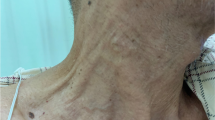Summary.
The co-existence of horseshoe kidney (HSK) and abdominal aortic aneurysm (AAA) is rare and demands a special diagnostic workup and a meticulous surgical procedure. Ten patients with HSK associated with AAA are reported. All underwent aortic replacement with successful preservation of multiple renal arteries. One patient died at the 7th postoperative day from myocardial infarction. HSK does not represent a contraindication for aortic repair. Angiography for identification of aberrant renal arteries and classification into three types for surgical management is mandatory. In type I and II we recommend a standard midline transperitoneal approach. Only in type III does a thoraco-abdominal approach seem favourable. The aortic reconstruction should be performed with tube grafts, if possible. Aberrant renal arteries are reattached directly to the prosthesis. Dissection of renal isthmus should be avoided. Temporary cold renal perfusion is indicated to extend the ischemic tolerance time. As repair of a ruptured AAA in patients with HSK may be quite difficult and time consuming, we recommend more liberal indications for aneurysm surgery in patients with HSK.
Zusammenfassung.
Das Vorliegen einer Hufeisenniere (HEN) ist eine seltene Abnormität, die im Zusammenhang mit aortalen Rekonstruktionen ein besonderes diagnostisches und chirurgisches Procedere verlangt. Es wird über 10 Patienten mit HEN und Bauchaortenaneurysma (BAA) berichtet. Die aortale Rekonstruktion gelang in allen Fällen bei Erhalt der multiplen Nierenarterien. Ein Patient verstarb am 7. postoperativen Tag am Myokardinfarkt. Eine HEN stellt per se keine Kontraindikation zur Aortenrekonstruktion dar. Mit der Angiographie, dem bildgebenden Verfahren der Wahl, ist eine Identifizierung der überzähligen Nierenarterien und eine Klassifizierung in 3 Versorgungstypen möglich. Ist eine mediane Längslaparotomie bei Typ I und II durchaus geeignet, so empfehlen wir bei Typ III einen thoracoabdominalen Zugang. Die Prothesenrekonstruktion der Aorta sollte möglichst kurzstreckig („tube graft“) gestaltet werden. Alle maßgeblichen Nierenarterien sind zu reinserieren. Der HEN-Isthmus muß nur in seltenen Problemfällen durchtrennt werden. Um die renale Ischämietoleranz zu verlängern, ist eine temporäre gekühlte Spülperfusion angezeigt. Im Rupturstadium des Aneurysmas steigt die Letalität bei Vorliegen einer HEN erheblich. Wir empfehlen daher eine erweiterte Indikationsstellung zur elektiven Operation.
Similar content being viewed by others
Author information
Authors and Affiliations
Rights and permissions
About this article
Cite this article
Luther, B., Sandmann, W., Reiher, L. et al. Aortenaneurysma bei Hufeisenniere – Spezielle Diagnostik und Therapie. Chirurg 68, 403–409 (1997). https://doi.org/10.1007/s001040050205
Issue Date:
DOI: https://doi.org/10.1007/s001040050205




